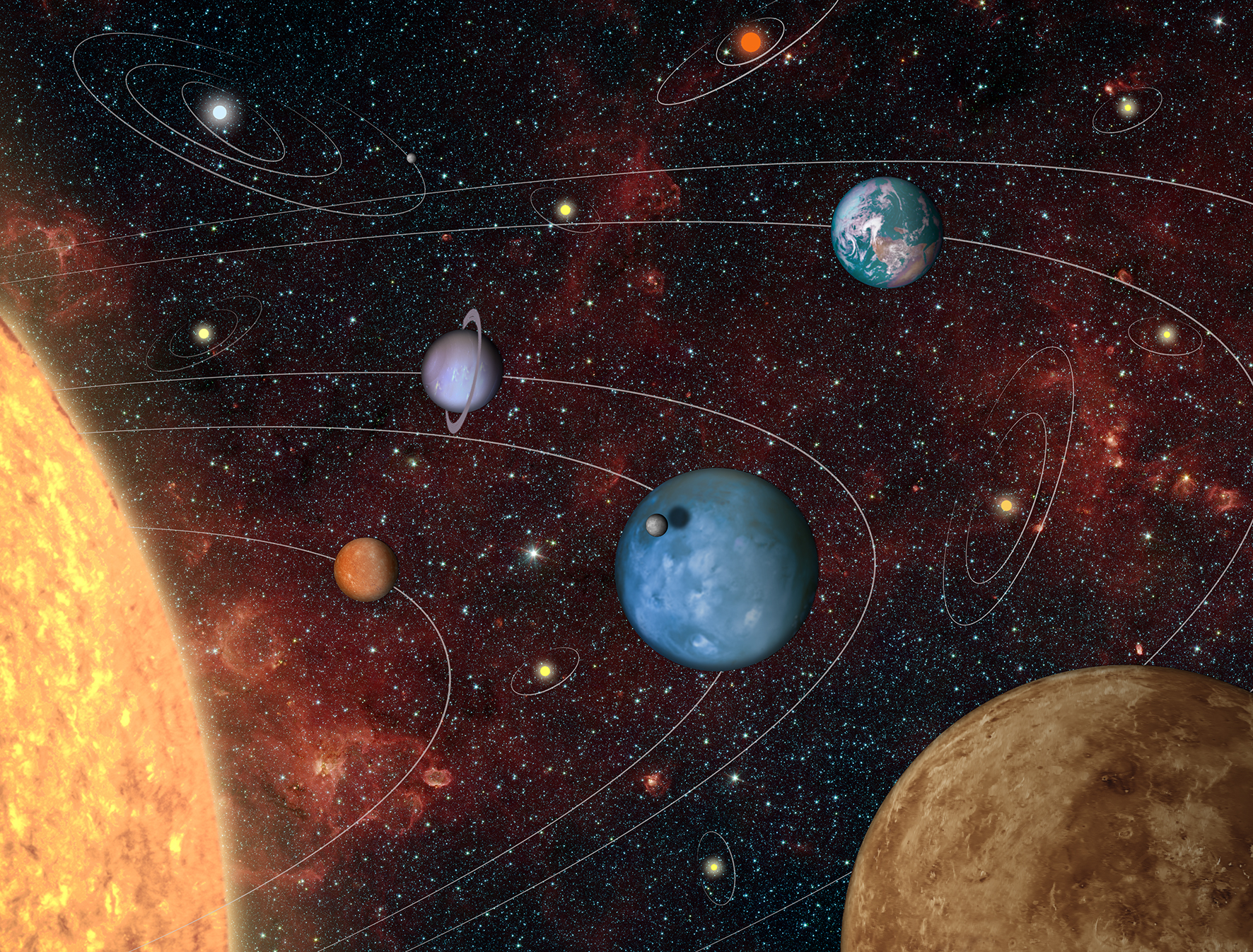The European Space Agency ESA has given the green light for the realisation of the space telescope PLATO, which will search for exoplanets from 2026 onwards. SRON Netherlands Institute for Space Research will test and characterise 8 of the 26 cameras for PLATO. In addition, SRON will develop models that can extract information from PLATO’s data about the atmosphere and clouds of such exoplanets. (Dutch follows)

PLATO’s task is to observe thousands of stars for a long period of time to discover if a tiny dip in light intensity occurs there. This happens when a planet passes in front of the star. The main aim of PLATO is to discover earth-like exoplanets and large ‘super-earths’ in the ‘habitable zone’ around stars like the Sun. This is the zone in which liquid water can exist on the surface of the planet. Extremely accurate and stable observations are needed over a period of several years to be able to measure the tiny dip that occurs as a consequence of this type of small planet. PLATO will also be able to determine several crucial characteristics such as the density of the planets.
With the draft plan for PLATO an international consortium of experts from Europe has responded to ESA’s call for the development of a mission for exoplanets. ESA’s decision today means that the mission has now passed the blueprint phase and that the European industry can now start building the telescope.
The PLATO telescope will consist of 26 individual optical cameras, 24 ‘normal’ and 2 ‘fast’, which partly overlap and will observe a large part of the cosmos. The extreme stability of the cameras, which is necessary for finding planets about same size as Earth requires highly accurate tests and knowledge about each detail of the camera. For this, experts from SRON, together with their colleagues in France and Spain, are simulating certain conditions in space such as the extremely low, cryogenic temperatures and the vacuum conditions. Only then, will they be able to gain a detailed understanding of the telescope’s behaviour once it has been launched into space.
Programme leader Michiel Min from SRON’s scientific programme for exoplanets is meanwhile developing models to extract atmospheric information from PLATO’s data. “At any rate PLATO will provide information about the radius, mass, density and age of a large collection of planets. So purely on the basis statistics we will be able to learn more about the formation and evolution of planets. However, for some planets PLATO will also enable us to examine the distribution of heat and clouds on the planet during ‘day’ and ‘night’. This will allow us to learn far more about the formation of clouds and the functioning of the atmosphere.”
Groen licht voor maken exoplaneet-telescoop PLATO
De Europese Ruimtevaartorganisatie ESA heeft groen licht gegeven voor de realisatie van de ruimtetelescoop PLATO die vanaf 2026 op zoek gaat naar exoplaneten. SRON Netherlands Institute for Space Research gaat 8 van de 26 camera’s van PLATO testen en karakteriseren. Daarnaast gaat SRON modellen ontwikkelen die uit PLATO’s gegevens informatie kunnen winnen over de atmosferen en wolken op zulke exoplaneten.

PLATO’s taak is om langdurig naar duizenden sterren te kijken, of zich daar een minieme dip in lichtsterkte voordoet. Dit gebeurt wanneer een planeet voor de ster langs schuift. De focus van PLATO ligt op het ontdekken van aardachtige exoplaneten en grote ‘super-aardes’ in de ‘bewoonbare-zone’ rondom sterren zoals de Zon. Dit is de zone waarin vloeibaar water op het oppervlak van de planeet kan bestaan. Er zijn extreem nauwkeurige en stabiele camerawaarnemingen over jaren nodig om de minieme dip als gevolg van dit soort kleine planeten te kunnen meten. Ook zal PLATO enkele cruciale eigenschappen, zoals bijvoorbeeld de dichtheid van de planeten, kunnen bepalen.
Een internationaal consortium van experts uit Europa beantwoordde met het concept voor PLATO de oproep van ESA voor de ontwikkeling van een missie voor exoplaneten. De beslissing van ESA vandaag betekent dat de missie uit de blauwdruk-fase komt en de Europese industrie aan de slag kan met de bouw van de telescoop.
De PLATO telescoop bestaat uit 26 losse optische camera’s, 24 ‘gewone’ en 2 snelle, die, gedeeltelijk overlappend, een groot stuk van de hemel bekijken. De extreme stabiliteit van de camera’s, nodig voor het vinden van planeten ter grootte van de Aarde, vereist zeer nauwkeurige tests en kennis van elk detail van de camera. Hiervoor simuleren experts van SRON, samen met collega’s in Frankrijk en Spanje, bepaalde omstandigheden in de ruimte zoals de extreem lage, cryogene temperaturen en de vacuüm condities. Alleen zo kunnen we het gedrag van de telescoop straks in vlucht tot in detail begrijpen.
Programmaleider Michiel Min van SRON’s wetenschappelijke programma voor exoplaneten buigt zich intussen over de ontwikkeling van modellen om atmosfeerinformatie uit de data van PLATO te winnen. “PLATO gaat sowieso de straal, massa, dichtheid en leeftijd van een grote verzameling planeten opleveren. Daardoor kunnen we alleen al op grond van statistiek meer over de vorming en evolutie van planeten leren. Maar PLATO stelt ons daarnaast ook in staat om van sommige exoplaneten de verdeling van warmte en bewolking op de planeet bij ‘dag’ en bij ‘nacht’ te bekijken. Hieruit kunnen we heel veel leren over de vorming van wolken en de werking van de atmosfeer.”


